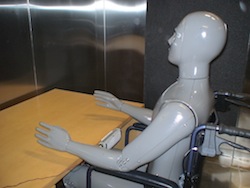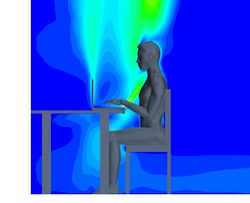Feel an Open Window Anywhere

Streamlines with Personal Breeze turned on
Airborne allergens and contaminants found in public places have been proven to have an adverse effect on people, such as a reduced productivity at the workplace, an increased exposure to diseases on airplanes, unhealthy lear ning environments for children, and sometimes the occur rence of secondary infections in hospitals. One potential solution is the use of personal air ventilation systems, or PAVs.
As the problem of poor indoor air quality reaches near epidemic levels (to the extent that certain environments are said to suffer from “Sick Building Syndrome”) and with people spending the vast majority of their time indoor, a solution needs to be found to help the millions of people who suffer due to transmitted disease and allergic reactions to airborne
pollutants.
Large, bulky, floor air purifiers are generally effective in small to medium rooms but tend to be noisy, expensive, and to consume large amounts of energy. Furthermore, in an open office setting, due to the large room volume and high airflow mixing, these units have only a minor
impact on overall air quality. At the other end of the spectrum, small wearable air purifiers typically do not remove contaminants well, and many release ozone as a bi-product of the filtration process, which is itself a pollutant.

Testing of Personal Breeze in Indoor Air Quality Chamber at Syracuse University using Thermal Manikin
With funding from the Syracuse Center of Excellence and U.S. Environmental Protection Agency, Propulsive Wing LLC, in collaboration with Allred & Associates Inc. and Syracuse University, has developed the Personal Breeze Air Purifier System, a revolutionary personal air
purifier that reduces contaminant and allergen exposure, delivering clean, fresh air to an individual. This methodology, which utilizes the individual’s self generated thermal plume to enhance cleaning effectiveness, is compact, quiet, and consumes only 2 watts.
By attaching the Personal Breeze to the front of a desk or to the tray table on an airplane, the user enjoys a light, refreshing breeze of filtered air. Instead of allowing allergens to flow freely up to the breathing zone, the contaminated airstream is diverted, filtered, and then re-injected back into the natural thermal plume.
This type of personal air purification provides filtered air to the user for only a fraction of the power consumption and noise of other products. In “breeze” mode, the air purifier simulates the natural fluctuations of real wind: it feels like there is an open window near
you, wherever you happen to be.
 The engineering simulation tool STAR-CCM+ was used to design and develop the Personal Breeze Air Purifier. Simulations were performed of a person working at a desk, onto which the PAV device has been attached. The PAV draws in air from the occupant’s thermal plume, filters it, and blows out a stream of clean air under the person’s chin.
The engineering simulation tool STAR-CCM+ was used to design and develop the Personal Breeze Air Purifier. Simulations were performed of a person working at a desk, onto which the PAV device has been attached. The PAV draws in air from the occupant’s thermal plume, filters it, and blows out a stream of clean air under the person’s chin.
Both the external (around the person) and internal (inside the ducting) airflows were modeled and simulated, and the results were used to optimize the air purifier configuration.
A number of cases were simulated with the Personal Breeze both off and on. In order to reduce the grid count, simplify the calculations and enable parametric studies, the rotating cross-flow fan of the Personal Breeze was modeled using a simple velocity inlet; this enabled the simulations to be run in steady state mode, thereby significantly reducing the simulation time. The grid was refined near the person, the laptop computer, and in proximity of the air purifier in order to correctly resolve the behaviors of the exhaust jet and of the flow in
the thermal plume. When the purifier is turned off, the thermal plumes rising from the person and the computer are clearly visible: STAR-CCM+ results show that the air breathed by the person originates from the floor, and moves up through the region at the front of the desk - where the PAV is optimally located - before reaching the breathing zone.
When the Personal Breeze is turned on, most of the air which reaches the breathing zone is filtered. Parametric studies were performed to evaluate the effect of the outlet flow velocity and angle in order to optimize the effectiveness of the device and minimize its power
consumption. One important characteristic of the Personal Breeze system is that the direction of the natural air flow is only very slightly altered; therefore, the energy input needed by the PAV is considerably reduced compared with a system which aims at significantly changing the
flow patterns.
Internal aerodynamic studies regarding the flow path within the air purifier were also performed. In particular, the relationships between fan size and speed, filter type, and filter and duct geometries were investigated to optimize both the power requirements and the dimensions of the PAV. In addition to being an effective filtration solution, the Personal Breeze was designed to be convenient to use in an office setting: the unit interfaces with a computer for power, control, and performance monitoring.
Finally, in order to assess and validate the effectiveness of the Personal Breeze system, prototypes were tested in the Building Energy and Environmental Systems Laboratory at Syracuse University. Compared with the ambient air, a reduction of up to 60% in particle contaminant levels in the breathing zone was demonstrated. The final design was proved to meet all specifications, including power consumption smaller than 2.5 watts, Windows-based control, rechargeable battery for portability, on-board environmental sensors and easy filter replacement.
Without STAR-CCM+, this would not have been possible within the time-frame of the 1-year grant period. Follow-on designs currently in development will add heating and cooling, humidification and dehumidification, and several other features, with the objective to provide a complete personal environmental solution for the office worker and the traveler.










